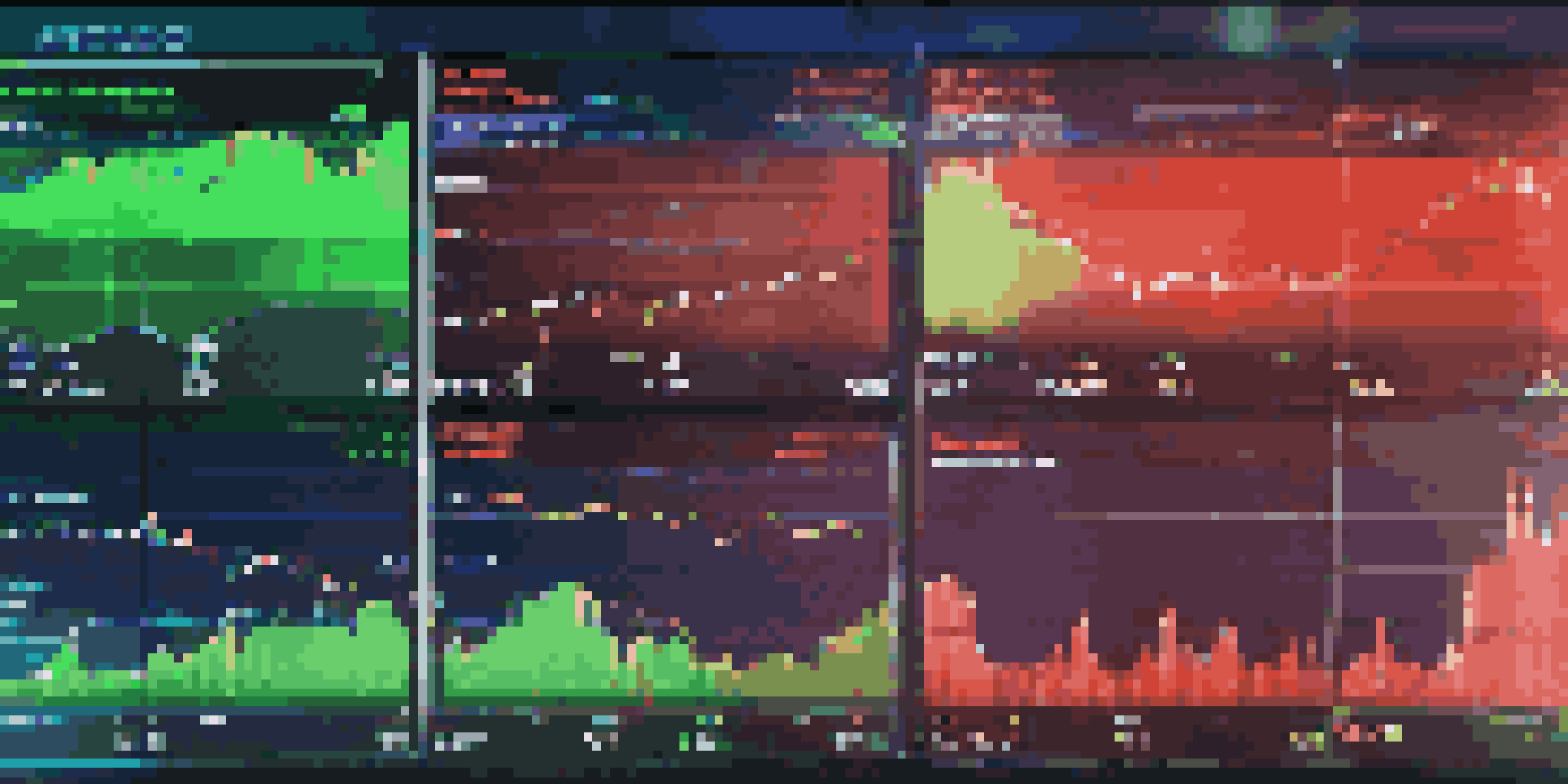How to Use Technical Indicators for Stock Trading

Understanding Technical Indicators in Stock Trading
Technical indicators are tools that help traders analyze price movements and trends in stocks. Think of them as a compass guiding you through the often murky waters of the stock market. By utilizing these indicators, traders can make more informed decisions about when to buy or sell stocks.
In trading, it's not about how much you make, but how much you don't lose.
There are various types of technical indicators, including trend indicators, momentum indicators, and volume indicators. Each serves a unique purpose and can offer insights into different aspects of stock behavior. For example, moving averages smooth out price data to help identify trends over a specific period.
While they can enhance your trading strategy, it's essential to remember that technical indicators are not foolproof. They should be used in combination with other analysis methods to develop a well-rounded trading approach. Just like a chef wouldn't rely solely on one ingredient, a trader should use multiple tools to create a successful strategy.
Types of Technical Indicators You Should Know
There are several key types of technical indicators, including moving averages, Relative Strength Index (RSI), and Bollinger Bands. Moving averages help smooth price data by creating a constantly updated average price, making it easier to identify trends. On the other hand, the RSI measures the speed and change of price movements, indicating overbought or oversold conditions.

Bollinger Bands are another popular indicator that consists of a middle band (the moving average) and two outer bands that represent standard deviations from the average. When the price approaches the outer bands, it can signal a potential reversal. Each of these indicators has its strengths and weaknesses, so understanding them is crucial for effective trading.
Key Types of Technical Indicators
Understanding various technical indicators like moving averages, RSI, and Bollinger Bands is crucial for effective stock trading.
Moreover, you can combine these indicators to create more robust strategies. For instance, using RSI alongside moving averages can help confirm whether a trend is gaining momentum. This layered approach can provide a clearer picture and increase the likelihood of making successful trades.
How to Interpret Moving Averages in Trading
Moving averages are one of the most widely used technical indicators, and for a good reason. They help to identify the direction of the trend by filtering out short-term price fluctuations. A simple moving average (SMA) calculates the average price over a specific number of periods, while an exponential moving average (EMA) places more weight on recent prices, making it more responsive to new information.
The market is a device for transferring money from the impatient to the patient.
When the price crosses above the moving average, it may signal a potential buying opportunity, while a cross below could indicate a sell signal. However, it’s essential to look at the context of the trend rather than relying solely on these signals. For example, a moving average crossover in a strong uptrend might be a good buying indication, but in a sideways market, it could lead to false signals.
Incorporating other indicators alongside moving averages can enhance their effectiveness. For instance, pairing SMAs with RSI can help determine whether a move is supported by momentum. This comprehensive analysis can help traders make more confident decisions.
Using RSI to Identify Market Conditions
The Relative Strength Index (RSI) is a momentum oscillator that ranges from 0 to 100 and is used to identify overbought or oversold conditions in a stock. Typically, an RSI above 70 indicates that a stock may be overbought, while an RSI below 30 suggests it may be oversold. This information can be crucial for timing your trades.
For instance, if you notice a stock’s RSI is approaching the 70 mark during an uptrend, it might be a good time to consider selling or at least setting a stop-loss. Conversely, an RSI below 30 in a downtrend could present a buying opportunity, especially if other indicators support this conclusion.
Combining Indicators for Success
Using multiple technical indicators together can help confirm signals and improve decision-making in trading.
However, relying solely on RSI can lead to misleading signals, particularly in strong trending markets. Therefore, it's best to combine RSI with trend indicators like moving averages to confirm your analysis. This way, you can ensure that your trade decisions are well-informed and grounded in multiple data points.
Bollinger Bands: A Visual Tool for Trading
Bollinger Bands are a versatile tool that visually shows potential price volatility and market trends. The bands consist of a simple moving average (middle band) and two outer bands that are standard deviations away from the average. When the price moves close to the upper band, it can indicate overbought conditions, while touching the lower band can signal oversold conditions.
Traders often look for price action to bounce off these bands as a signal for potential reversals. For example, if the price breaks above the upper band, it may be time to sell or take profits, while a move below the lower band could indicate a buying opportunity. This visual representation can make it easier to spot trading opportunities at a glance.
It's worth noting that Bollinger Bands work best in conjunction with other indicators. For instance, if you see the price hitting the lower band while the RSI is also showing oversold conditions, it can strengthen your conviction to buy. This multi-faceted approach can provide a better sense of risk and reward.
The Role of Volume Indicators in Trading Decisions
Volume indicators measure the number of shares traded during a specific time period and can provide insight into the strength of a price move. High volume often indicates strong interest and can confirm whether a trend is likely to continue. For example, if a stock price rises significantly on high volume, it may suggest strong buying interest, making it a more reliable move.
Conversely, if a price movement occurs on low volume, it might not be sustainable. For instance, a stock that jumps in price with little trading activity could see a quick reversal. Thus, monitoring volume alongside price movements can enhance your trading decisions.
Volume Indicators Enhance Insights
Monitoring volume alongside price movements provides valuable insight into the strength and sustainability of price trends.
Incorporating volume indicators like On-Balance Volume (OBV) or the Accumulation/Distribution line can provide further insights. These tools help you track buying and selling pressure, allowing for a more comprehensive understanding of market dynamics. Ultimately, analyzing volume can help you make more informed trading choices.
Combining Technical Indicators for Better Trading
One of the most effective strategies in stock trading is combining multiple technical indicators to create a well-rounded approach. This technique allows traders to confirm signals and reduce the likelihood of false positives. For example, using moving averages alongside RSI can help validate whether a price movement is supported by momentum.
When you see a moving average crossover and the RSI is confirming overbought or oversold conditions, it strengthens your trading signal. This layered approach can provide a clearer picture of market conditions and better inform your decisions.

However, it's essential to strike a balance. Overloading on indicators can lead to analysis paralysis, making it difficult to decide on a course of action. Instead, choose a few complementary indicators that align with your trading strategy and stick to them for more effective results.